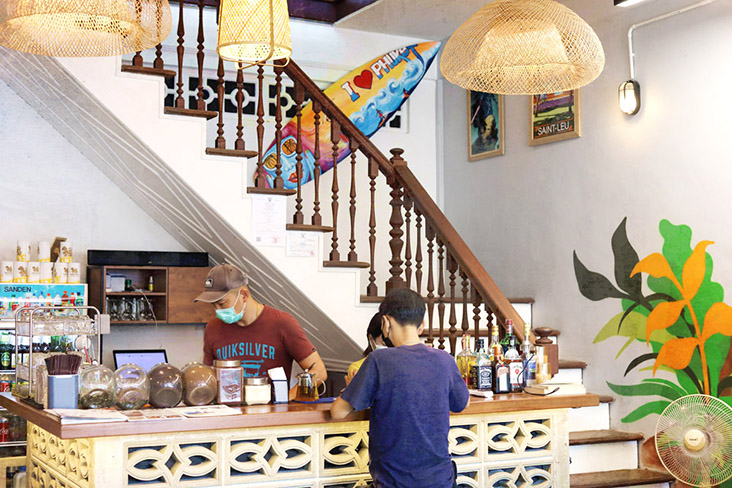PHUKET, March 10 — It’s the colour that is unmistakable. Fiery red and spicy orange, the broth is suffused with coconut milk and homemade sambal. The noodles resting within the soup is nearly hidden beneath the generous toppings of prawns and fish cakes, halved hard boiled eggs and tempting cockles.
This, you decide, is a worthy bowl of laksa.
Sounds like something you’d find in Penang, Malacca or Singapore, right? Yet this sumptuous bowl is found many miles further north in the Thai island of Phuket. Specifically this laksa is the signature dish at Lao Pa Sat Phuket Town.
That’s right, there is Singaporean and Malaysian fare even in this idyllic tourist haven. While Phuket has its own Peranakan heritage (not unlike the three former Straits Settlements mentioned earlier), that is not the reason behind the existence of this much-loved laksa.
According to Joe Ang, the friendly owner of Lao Pa Sat, there is a sizeable community of Singaporeans and Malaysians living on the island. Ang had moved to Phuket from Singapore and both his parents are Malaysians, hence his deep love for our shared cuisine.
The name Lao Pa Sat means “old market” in Hokkien and pays homage to a similarly named and iconic establishment in the Lion City. The Singaporean original (its name stylised as “Lau Pa Sat” or Lǎo Bāshā in Mandarin) is a former market turned food court, housed in one of the oldest Victorian structures in South-east Asia.

Lao Pa Sat Phuket Town is a unique entity unto itself however, with a beach town feel to its décor, easygoing and charming in equal measure.
On an island where most locals and visitors start the day with moo ping and gai yang (grilled pork and chicken) paired with glutinous rice or khao tom (rice soup), those of us who are hankering for must-have kopitiam staples such as butter kaya toast and half boiled eggs may satisfy those cravings here.
The roti bakar cut into sharp, rectangular slices, the cold butter melting with the heat of the toast, the inimitable coconut-and-pandan fragrance of the kaya — there’s little wonder why, for Singaporeans and Malaysians alike, there’s no toast like butter kaya toast.

Then there’s the tricky matter of the half boiled eggs. Some of us are all too familiar with the disappointment that comes when you crack open the eggs to reveal overcooked yolks or whites that are basically still raw albumen.
No such danger here; Lao Pa Sat’s half boiled eggs more than pass muster. Add a few drops of soy sauce and anoint the liquid manna with a dash of ground white pepper, and you have a protein rich breakfast for champions.
The space itself doesn’t try to emulate a traditional kopitiam, however. With colourful murals — ocean waves, coconut trees and hills made for hiking dominate (plus some pink toned sea monsters?) — and framed Art Deco posters of other holiday locales, the ambience is one of relaxation.

This is a place for one to restore oneself, our surroundings seem to say, mind, body and soul. Naturally, the best way to approach such a recuperative process is with food we love and remember; where every bite or sip is a fond childhood memory.
Whether it’s fork tender beef rendang or fried rice suffused with wok hei, it’s the taste of home away from home for Singaporeans and Malaysians in Phuket, from long-time residents to weekend tourists.

Besides the rich and creamy laksa, Lao Pa Sat also offers other Singaporean style favourites: a slightly sweet char kway teow; hae-mee or Hokkien fried noodles, the version with seafood rather than the dark soy sauce slicked one popular in the Klang Valley; and Hainanese chicken rice with sio bak (crispy pork).
But no meal would be complete without some local coffee. “Local” here takes two meanings, deriving its form from kopitiam style beverages such as kopi and kopi O whilst the coffee beans are sourced from Elephant Nature Park in Chiang Mai.
Ang calls this “nu-traditional kopi” which just means every sip will taste familiar yet fresh at the same time. Not a fan of caffeine? Sate your thirst with a refreshing glass of soya cincau — that black-and-white pairing of grass jelly and soy milk.


You’re probably stuffed by now but Ang reminds you it’s the weekend. On Saturdays and Sundays, customers can enjoy Lao Pa Sat’s most prized dish — what is probably the best nasi lemak in Phuket.
Aromatic rice steamed with coconut milk, homemade sambal, triangles of omelette, fried groundnuts and ikan bilis, discs of cool cucumber, and a choice of fried chicken or crispy fish — now that is truly the taste of home away from home.
Lao Pa Sat Phuket Town
1 Phangnga Rd, Tambon Talat Yai, A.Muang, Phuket 83000, Thailand
Open daily (except Mon closed) 10:30am-8pm
Tel: +66 86 330 8812
Web: laopasat-phuket-town.business.site
For more slice-of-life stories, visit lifeforbeginners.com.






















